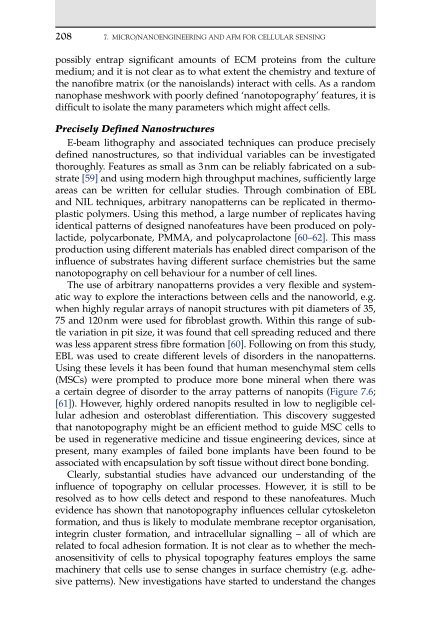W. Richard Bowen and Nidal Hilal 4
W. Richard Bowen and Nidal Hilal 4
W. Richard Bowen and Nidal Hilal 4
- No tags were found...
Create successful ePaper yourself
Turn your PDF publications into a flip-book with our unique Google optimized e-Paper software.
208 7. MICRO/NANOENgINEERINg ANd AFM FOR CELLULAR SENSINg<br />
possibly entrap significant amounts of ECM proteins from the culture<br />
medium; <strong>and</strong> it is not clear as to what extent the chemistry <strong>and</strong> texture of<br />
the nanofibre matrix (or the nanoisl<strong>and</strong>s) interact with cells. As a r<strong>and</strong>om<br />
nanophase meshwork with poorly defined ‘nanotopography’ features, it is<br />
difficult to isolate the many parameters which might affect cells.<br />
Precisely Defined Nanostructures<br />
E-beam lithography <strong>and</strong> associated techniques can produce precisely<br />
defined nanostructures, so that individual variables can be investigated<br />
thoroughly. Features as small as 3 nm can be reliably fabricated on a substrate<br />
[59] <strong>and</strong> using modern high throughput machines, sufficiently large<br />
areas can be written for cellular studies. Through combination of EBL<br />
<strong>and</strong> NIL techniques, arbitrary nanopatterns can be replicated in thermoplastic<br />
polymers. Using this method, a large number of replicates having<br />
identical patterns of designed nanofeatures have been produced on polylactide,<br />
polycarbonate, PMMA, <strong>and</strong> polycaprolactone [60–62]. This mass<br />
production using different materials has enabled direct comparison of the<br />
influence of substrates having different surface chemistries but the same<br />
nanotopography on cell behaviour for a number of cell lines.<br />
The use of arbitrary nanopatterns provides a very flexible <strong>and</strong> systematic<br />
way to explore the interactions between cells <strong>and</strong> the nanoworld, e.g.<br />
when highly regular arrays of nanopit structures with pit diameters of 35,<br />
75 <strong>and</strong> 120 nm were used for fibroblast growth. Within this range of subtle<br />
variation in pit size, it was found that cell spreading reduced <strong>and</strong> there<br />
was less apparent stress fibre formation [60]. Following on from this study,<br />
EBL was used to create different levels of disorders in the nanopatterns.<br />
Using these levels it has been found that human mesenchymal stem cells<br />
(MSCs) were prompted to produce more bone mineral when there was<br />
a certain degree of disorder to the array patterns of nanopits (Figure 7.6;<br />
[61]). However, highly ordered nanopits resulted in low to negligible cellular<br />
adhesion <strong>and</strong> osteroblast differentiation. This discovery suggested<br />
that nanotopography might be an efficient method to guide MSC cells to<br />
be used in regenerative medicine <strong>and</strong> tissue engineering devices, since at<br />
present, many examples of failed bone implants have been found to be<br />
associated with encapsulation by soft tissue without direct bone bonding.<br />
Clearly, substantial studies have advanced our underst<strong>and</strong>ing of the<br />
influence of topography on cellular processes. However, it is still to be<br />
resolved as to how cells detect <strong>and</strong> respond to these nanofeatures. Much<br />
evidence has shown that nanotopography influences cellular cytoskeleton<br />
formation, <strong>and</strong> thus is likely to modulate membrane receptor organisation,<br />
integrin cluster formation, <strong>and</strong> intracellular signalling – all of which are<br />
related to focal adhesion formation. It is not clear as to whether the mechanosensitivity<br />
of cells to physical topography features employs the same<br />
machinery that cells use to sense changes in surface chemistry (e.g. adhesive<br />
patterns). New investigations have started to underst<strong>and</strong> the changes
















